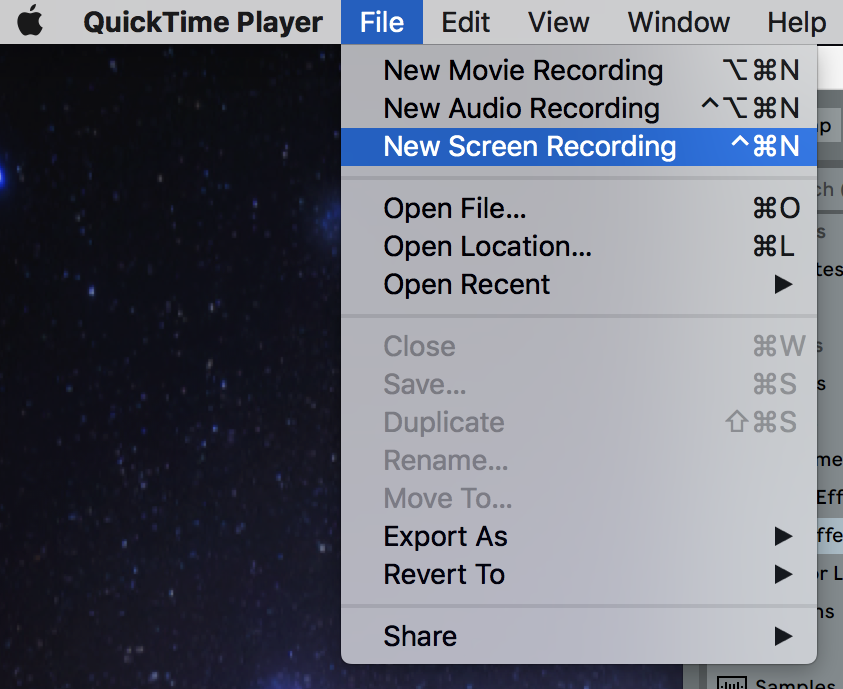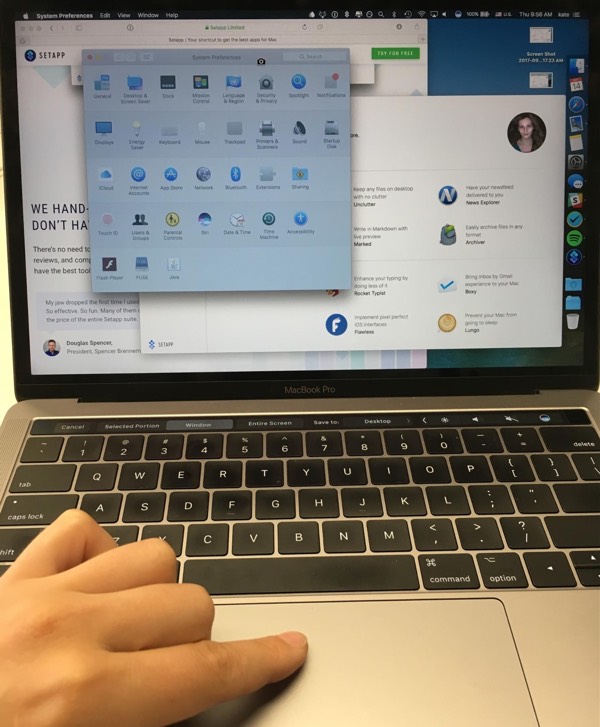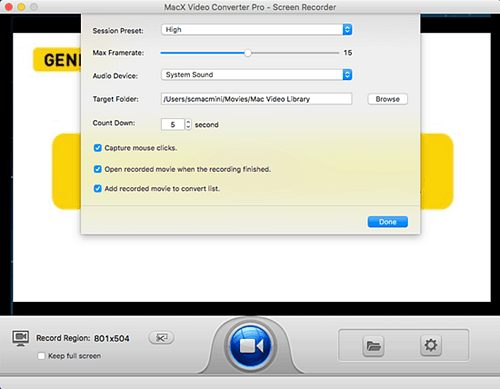Screen Record On Mac Pro

On your Mac, press Shift-Command-5 (or use Launchpad) to open Screenshot and display the tools. Click a tool to use to select what you want to capture or record (or use the Touch Bar). For a portion of. Using the Screen Recorder in Mac OS X. The screen recorder function is included with QuickTime Player in Mac OS X 10.6 – 10.9 and later. Here’s how to use it to capture a video of the Mac screen in action: Launch QuickTime Player (located in /Applications/) Pull down the File menu and select “New Screen Recording”. To record the entire screen, click anywhere on the screen. To record a section of the screen, click and drag the cursor to create a window (you can resize or move it if you wish) and then click the.
Have you wondered how to record your screen on a Mac? How to screen record on a Mac with sound? Perhaps you want to record tutorials for software you like, make software reviews, or record yourself playing video games. How do you do it? There are some key things you should know before you pick the right software to do it.
How to screen record on Mac with audio:
- Launch Screenflick
- Click 'Record System Audio' to capture the sound playing on your Mac
- Click 'Record Microphone' to record your voice
- Click 'Record Camera' to record your FaceTime camera
- Select the area of the screen (or full screen) to record
- Start the Recording!
Some of the great features of Screenflick
- High Performance Recording
- Record System Audio
- Record Microphone Audio
- Record Video Camera
- Hide the Mouse Cursor
- Mouse & Keyboard Display
- Record High Resolution Screens
- Recording Scale & Frame Rate
- Cursor-Following Modes
- Create Timelapses
- Flexible Export Options
- Draw on Your Screen

Whatever it is you want to record, Screenflick is a great tool to get it done.
Quick Contents:
Screenflick - A Better & Faster Mac Screen Recorder
Unlike QuickTime Player, Screenflick is a real screen recording application for your Mac which has a wealth of features to control the recording and exporting, while being well-known as easy to use. With Screenflick you can record smooth high quality recordings of your Mac's screen with system audio, microphone audio, and even picture-in-picture from a video camera. Screenflick can optionally display mouse clicks and keyboard keypresses, add an emblem/watermark image to the recording, and offers plenty of control over recording and exporting settings so you can use it to do exactly what you want.
Using Screenflick to Record Your Mac Screen
- Open Screenflick
- Optionally change any of the recording settings to suit your needs
- Click the recording button
- Select the area of the screen to record and start recording
- Stop the recording when you're done
- Optionally change any of the export settings to suit your needs
- Export the recording
If you don't need or want to change any settings, it's as simple as it gets to use, but because you can customize many settings, it's much more useful and powerful. See more about how to use Screenflick.
Some of the great features of Screenflick
- High Performance Recording — Because Screenflick doesn't record directly to an H.264-encoded movie file, it has great performance allowing you to record high resolutions at high frame rates, and at higher quality than H.264 movies typically allow. Record full screen games up to 60 fps.
- Record System Audio — Built-in support for one-click system audio recording. Record the audio from games and other applications.
- Record Microphone Audio — Record the built-in microphone or any other mic plugged into your Mac.
- Record Video Camera — For example, record your Mac's built-in FaceTime camera to create a picture-in-picture overlay
- Hide the Mouse Cursor — Don't want the cursor shown? Hide it so it's not in the recording at all.
- Mouse & Keyboard Display — Optional display of mouse clicks and keyboard keypresses with customizable styling.
- Record High Resolution Screens — Record even large Retina screens, with high frame rates, both at Retina and non-Retina scales.
- Recording Scale & Frame Rate — Customize the scale and frame rate for extra precise control over performance. (For example, using a 720p recording scale on a 15' MacBook Pro improves performance by 80% over QuickTime Player. That means more of your computer's power is saved for what you're recording, instead of using that power just trying to record it.)
- Cursor-Following Modes — With Screenflick, you can choose to record a small-sized area around the cursor, and it'll follow the cursor everywhere on your screen. Perfect for recording application demos and tutorials on large screens.
- Create Timelapses — In Screenflick you can control the frame rate of the recording and the time scaling of the movie. This means you can set to record at a low frame rate, such as 3 frames per second, record yourself for an hour, speed up the recording by 10x and create a wonderfully smooth 6 minute timelapse, all while using very little energy/processing time (battery life!) during the recording itself.
- Flexible Export Options — Choose amongst file formats, video compression options, audio compression options, target ProRes files for highest quality imports into iMovie and Final Cut, control exported dimensions, frame rate, and time scaling of the movie file and more.
QuickTime Player – Not The Best
QuickTime Player is an application from Apple that comes with every Mac. You've probably already used it when watching different movie files or listening to audio files that are on your Mac. Well, not only can QuickTime Player watch video and audio files, but it can create them too, including screen recording movies. Using QuickTime Player to record your screen is simple:
- Open QuickTime Player
- Choose File -> New Screen Recording from the menubar
- Click on the record button in the window
- Select which area of the screen to record (full screen, or just part of it)
And off you go. To stop the recording, click on the stop button in the menubar. After that, you can save the file, share it on YouTube, import into iMovie, etc. Whatever you want.
Why QuickTime Player Isn't the Best Choice
QuickTime Player is free, is already on your Mac, and is simple. It's great, but unfortunately it's also a bit limited in several ways. Here are just some of the ways QuickTime Player doesn't live up to most uses:
- No System Audio — Any of the audio playing on your Mac isn't recorded. QuickTime Player can record your microphone and your video camera, but there's no built-in way for it to capture any of the audio playing in movies, games, or any other software running on your Mac.
- Low Performance — QuickTime Player uses real-time encoding to H.264. In plain English, this means it creates a final movie file that's ready immediately when you stop the recording. That's useful, but unfortunately H.264 is really difficult for computers to encode, so most Macs simply can't keep up; especially when recording full screen. At large resolutions, the amount of data your computer needs to compress to create a final movie file in real-time is extremely demanding. So as an example, QuickTime Player (or any other software using real-time H.264 encoding) on even the highest end Macs will have difficulty with recording full screen games with it leaving you with a low frame rate movie file which will look very 'stuttery' or 'laggy.' QuickTime Player is not good for recording games.
- Poor Quality Control — Not only does the real-time H.264 encoding have an impact on performance, but it has one on quality too. H.264 movies naturally have reduced quality as part of the compression scheme to make the file size small. That compression means the file is already lower quality – quite possibly lower than you want, especially if you're going to import it into a movie editor like iMovie or Final Cut, which then will cause further quality loss. QuickTime Player does let you pick a 'maximum quality' mode, but then the file sizes of the recordings are enormous, requiring huge amounts of disk space which is impractical for large recordings.
- Mouse & Keyboard Display — Seeing what's on screen is only part of what viewers may need to see in your recordings. Very often it's useful to see when the mouse is being clicked, which button is clicked, which keyboard key-combinations are pressed for shortcuts, etcetera. QuickTime Player can show mouse clicks, but only as a brief flash of an ugly plain black circle; It can't show which button was clicked, modifiers held during the click, or keyboard keypresses at all.
- No Cursor Following — If you want to record just a small area of the screen, QuickTime Player is locked into recording only that one small area, and nothing outside of it. A good screen recorder offers the capability to record a small-sized area that follows the mouse cursor around, so you can still use the entire screen, and capture everything you're doing on it. This is tremendously useful, and QuickTime Player can't do it.
- No Timelapses — If you're an artist wanting to capture a timelapse recording of yourself creating digital artwork, forget about using QuickTime Player because it simply can't do it. Not only can you not control the recording settings so that it's not wasting tons of energy and processing time recording data that won't be used anyway, but QuickTime Player also can't speed up the recording anyway.
- Few Export Options — QuickTime Player is severely limited in how it can save files. Your choices are limited to a single movie file format, no control over the audio, and you can only export with the dimensions it already it is in, or 1080p or 720p. That's it. No specifying custom dimensions, no scaling by percentage, no control over aspect ratios, no choice over the quality of the exported file… none of that.
- And many more limitations…
While QuickTime Player is very simple to use, its simplicity also makes it useless except for the simplest of purposes. In summary, it's good for capturing a small area of the screen, with no system audio, for a short duration of time, where you want no control over the size, quality, or format of the result. Beyond that, it's not what you want.
QuickTime Player is Okay for:
- Capturing a small area of the screen, for a short duration, without any system audio

QuickTime Player is Bad for:
- Games
- Application tutorials
- Professionals
- Artist timelapses
- Pretty much everything
Conclusion

Screenflick offers far more features, flexibility, and performance better than QuickTime Player, while still being really easy to use. There's a reason that Screenflick is a very popular screen recording tool used by everyone from 8 year-old YouTubers, gamers, software developers, and professional software trainers. Whatever it is you want to record, Screenflick is a great tool to get it done.
From time to time, you may need to make video tutorials, grab the funny parts of a video or create video software reviews, then recording screen on Mac will be highly recommended for its high quality and high performance. Thus do you know how to record screen and audio at the same time on Mac? Don't worry about it. In this article, you will learn 2 methods to record screen on Mac with sound by using 2 different but feasible Mac Screen Recorder. The first one is called TuneFab Screen Recorder and the other is using the default apps on Mac called QuickTime Player. Let's go and read how to make it in a few steps.
You'll Need:
1. How to Record Screen on Mac with Audio
TuneFab Screen Recorder is designed for recording screen and audio at the same time on Mac and save as multiple video formats such as MP4, MOV, M4V and more. With it, you can not only record the screen on Mac but also edit the video when recording with various edit functions, like drawing an arrow, adding a text and more. Apart from these powerful functions, there are Webcam Recorder, Audio Recorder and more available.
Support System: TuneFab Screen Recorder is fully compatible on MacBook Air, Macbook Pro, iMac and Mac mini with macOS 10.9 to 10.15 running.
Download TuneFab Screen Recorder for Mac Here
Step 1. Run TuneFab Screen Recorder for Mac

Get started with downloading TuneFab Screen Recorder for Mac by clicking on the button above and then installing it on your Mac. After that, run it on your MacBook Air, MacBook Pro or other Mac to get ready recording Screen on Mac with audio and you will see the main interface as below. Now enter to Video Recorder mode.
Step 2. Turn on Microphone or System Sound for Recording Audio
Before turning on Microphone, you need to fully install Audio Driver of TuneFab Screen Recorder for Mac on your Mac first. After that, on the main interface of TuneFab, turn on System sound or Microphone for recording your Mac screen with sound.
Step 3. Draw a Recording Area from 2 Options
Customize the whole recording area are needed before recording. As you can see on the main interface of TuneFab Screen Recorder, there are 2 buttons available for options.
Hit to Full button, you can record the whole screen on Mac with sound so that you can free from drawing a recording area.
Choose the Custom button, you can choose the recording area size or select region or Windows for recording partial screen of your Mac with sound.
Step 4. Record Screen on Mac with Audio By Clicking to REC
It is the last step for you to make it. Now you can just click to the green REC button for recording screen on Mac. With 3 seconds countdown, you can record Screen on Mac and sound together.
Click to the red-square button to end up the whole recording. Don't forget to preview the video and check if the whole recording is meet your needs or not. If yes, then hit to Save button to save your recorded video on Mac.
For Free Trial version: You just allowed to record the screen on Mac with 3 minutes long video. With 3 minutes recording, you can fully evaluate both recording functions and video quality.
Screen Record Macbook Pro 2011
Besides, you can try the default way to record the screen on Mac with audio, using SoundFlower with Quicktime Screen Recording function to record Mac screen with sound. So that you can make up your mind on choosing your best way to screen record on Mac with sound. Keep reading and see how to make it.
Screen Record Macbook Pro 2012
2. Add SoundFlower to QuickTime Screen Recording with Sound
Macbook has a built-in app called QuickTime Player, which is available for playing the multimedia files with a built-in function, the screen recording. However, if you record Screen with QuickTime Player, you may have found that it is hard for you to record screen with sound for QuickTime Player don't allow you to set the audio input as internal Microphone. So how to fix it? Keep reading.
Step 1. Download SoundFlower on Your Mac
Download SoundFlower for Mac on your Mac and then fully installed it on your Mac. After the installation, run it on your Mac.
How do I know if SoundFlower for Mac is fully compatible? SoundFlower is fully compatible with macOS from 10.10 to 10.15. So if your Macbook still running on macOS 10.9, then you should back to the first method.
Step 2. Launch QuickTime Player on Your Mac
Here on your Mac Screen, click on LaunchPad and then choose QuickTime Player then you will see the Menu bar have shifted to QuickTime Player. Click on File next to QuickTime and select the New Screen Recording to launch QuickTime Screen Recording.
Step 3. Choose SoundFlower as your QuickTime Screen Recording Audio Input
Screen Record On Mac Os
On the main interface of Screen Recording, here is a down-arrow button for you to choose the Audio Input. Click on the Down-arrow button and choose SoundFlower as your sound device. After that, click on the red-circle button for getting started with QuickTime Screen Recording with sound. When it is over, click to Red-button to end up the whole recording. Previewing the whole recorded video are allowed for you after the whole recording is finished.
Now, you've got 2 methods of record screen and audio at the same time on Mac. How do you think of recording mac Screen with audio now? Is it easier than ever before? As a matter of fact, using a Mac screen Recorder will be more helpful than using QuickTime Player for the various output format and video quality options. Here, tell us your feelings about this post or share it with your friends if you have any problems. That's all for today, see you next time.